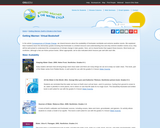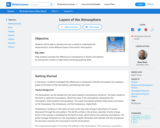
French Speak the Response What's the weather like?
- Subject:
- Arts and Humanities
- Languages
- Material Type:
- Interactive
- Provider:
- Michigan Virtual
- Date Added:
- 04/03/2020

French Speak the Response What's the weather like?

Can-Do Statement about Identifying Climate and Geographic Features

French Vocabulary Quiz about Weather and Geography

Season and Weather Drag and Drop Fill in the Blanks Quiz

In this weather-related activity, learners make a portable cloud in a bottle. Learners discover that clouds form when invisible water vapor in the air is cooled enough to form tiny droplets of liquid water. You an accomplish the same cooling effect by rapidly expanding air in a jar using a wide-mouth jar, rubber glove, matches, and tap water. This activity can be conducted as a demonstration or by learners with adult supervision.

The books selected for this list complement articles in the issue of Beyond Weather and the Water Cycle that introduce the concepts of water availability and of extreme weather conditions. In nonfiction and fiction, the books for Grades K-5 emphasize that freshwater is a limited resource and explain how and why extreme weather events occur.

French Vocabulary Audio Clip It was sunny

French Vocabulary Audio Clip It was cold

French Vocabulary Audio Clip It's Hot

French Vocabulary Audio Clip It's five degrees

French Vocabulary Audio Clip It's Cold

French Vocabulary Audio Clip It's thirty-five degrees

French Vocabulary Audio Clip It was snowing

French Vocabulary Audio Clip It's raining

French Vocabulary Audio Clip It was raining

French Vocabulary Audio Clip There are clouds

French Vocabulary Audio Clip There's a storm

Objective
Students will be able to develop and use a model to understand the characteristics of the different layers of the Earth's Atmosphere.
Big Idea
Help students visualize the differences in temperature in Earth's atmosphere by having them create a model while practicing graphing skills.

Have you ever heard someone ask something like, “If the Earth is really experiencing Global Warming, then how can my town be experiencing record-breaking cold and snowfall this year?” This type of misunderstanding can arise because of people’s confusion about the difference between weather (short-term conditions) and climate (long-term patterns and trends). In this lesson, students will review the difference between weather and climate so that this type of misconception doesn’t interfere with their learning about climate change in subsequent lessons.

Throughout the module, students study the anchor phenomenon, the cliff dwellings at Mesa Verde, and build an answer to the Essential Question: How did the cliff dwellings at Mesa Verde protect people from the weather? As students learn about each new concept, they develop and refine a model that represents a cliff dwelling and use that model to explore how cliff dwellings protected people from the weather. At the end of the module, students use their knowledge of weather to explain the anchor phenomenon, and they apply their learning to a new context in an End-of-Module Assessment. Through these experiences, students begin to establish an enduring understanding of weather and its effects. Specifically, students develop an understanding of the parts of weather, the effects weather has on people and their surroundings, and the ways people prepare for severe weather.
With PhD Science®, students explore science concepts through authentic phenomena and events—not fabricated versions—so students build concrete knowledge and solve real-world problems. Students drive the learning by asking questions, gathering evidence, developing models, and constructing explanations to demonstrate the new knowledge they’ve acquired. The coherent design of the curriculum across lessons, modules, and grade levels helps students use the concepts they’ve learned to build a deep understanding of science and set a firm foundation they’ll build on for years to come.
Cross-curricular connections are a core component within PhD Science. As an example, every module incorporates authentic texts and fine art to build knowledge and create additional accessible entry points to the topic of study.
Three-dimensional teaching and learning are at the heart of the curriculum. As students uncover Disciplinary Core Ideas by engaging in Science and Engineering Practices and applying the lens of Cross-Cutting Concepts, they move from reading about science to doing science.
© 2020–2022 Great Minds PBC. Except where otherwise noted, this content is published under Great Minds OER License 1 (greatminds.org/gm_oer_1). Use limited to noncommercial educational purposes. COMMERCIAL REPRODUCTION PROHIBITED.